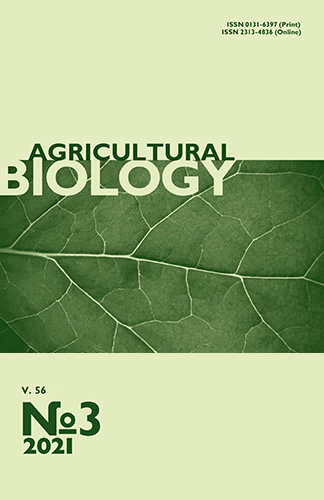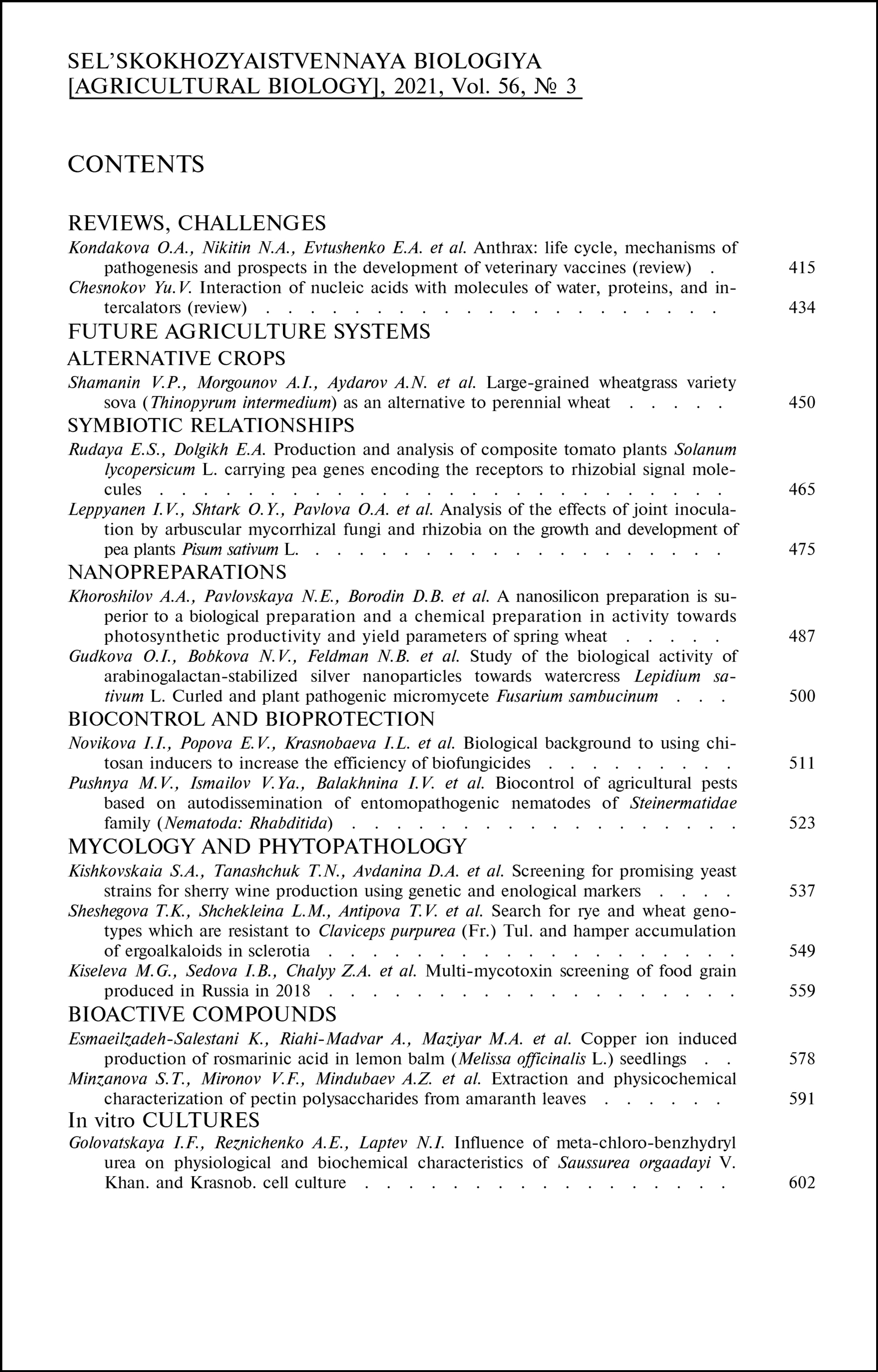doi: 10.15389/agrobiology.2021.3.523eng
UDC: 634.11 + 633.1]:632.7:632.937:632.98
Acknowledgments:
We are grateful to Ph.D. V.V. Kostyukov for help in identifying the species of entomophages of the families Braconidae and Ichneumonidae.
The research was carried out within the framework of the State Assignment of the Ministry of Science and Higher Education of the Russian Federation (the topic No. 0686-2019-0010)
BIOCONTROL OF AGRICULTURAL PESTS BASED ON AUTODISSEMINATION OF ENTOMOPATHOGENIC NEMATODES OF Steinermatidae FAMILY (Nematoda: Rhabditida)
M.V. Pushnya ✉, V.Ya. Ismailov, I.V. Balakhnina, E.Yu. Rodionova,
E.G. Snesareva, A.A. Komantsev
Federal Research Centre of Biological Plant Protection, 14, ul. Vavilova, Krasnodar, 350039 Russia, e-mail mar.pushnya2014@yandex.ru ( ✉ corresponding author), vlyaism@yandex.ru, balakhnina@yandex.ru, rigaeyu@gmail.com, greas23@yandex.ru, alex.agro83@mail.ru
ORCID:
Pushnya M.V. orcid.org/0000-0002-7133-9533
Rodionova E.Yu. orcid.org/0000-0001-5631-2204
Ismailov V.Ya. orcid.org/0000-0002-6713-0059
Snesareva E.G. orcid.org/0000-0003-4617-3604
Balakhnina I.V. orcid.org/0000-0002-2326-221X
Komantsev A.A. orcid.org/0000-0003-1136-3264
Received April 27, 2021
At present, the development of biological plant protection systems is among the most important economic, social and environmental challenges. Creating an effective system is impossible without the combination of a variety of biological agents and pest control techniques. Combining a variety of pathogenic organisms and synthetic sex pheromones is a way to improve the situation. This paper shows the effectiveness of entomopathogenic nematodes (EPN) of the family Steinernematidae Filipjev, 1934 as an autodissemination agent for agro-ecosystems under crop rotation and at apple-tree orchard, and assessed the effect of introducing pathogens on indigenous entomopathogens in soil. In particular, a decrease in the number of harmful insects and an increase in the activity of natural beneficial entomopathogens have been demonstrated. The essence of the method consists in the targeted introduction of entomopathogenic bioagents into the agro-ecocenosis by means of their application to attracted insects caught in traps, and thus creating an epizootic in the populations of target species. Previously, entomopathogenic nematodes were not used as autodissemination agents against superdominant species, the codling moth Cydia pomonella L., 1758 and click beetles of the family Elateridae Leach, 1815; moreover, their effect on other members of the entomofauna of agro-ecocenoses has not been studied either. The purpose of this work was to evaluate the effectiveness of the EPN autodissemination method for various cultures. The successful testing of Granulosis virus dissemination method in the apple orchard and the EPN autodissemination against wireworms prompted us to conduct the investigation reported herein. Two species of entomopathogenic nematodes of Steinernematidae family, the Steinernema carpocapsae (Weiser, 1955) and St. feltiae (Filipiev, 1934) were reproduced in lab culture in different host insects to produce nematode inoculums. The experiments found out that specially designed formulations and modified pheromone traps ensure EPN introduction into the agrocenoses due to nematode invasion of trapped insects followed by their free flight to spread pathogens. As a result, the nematode-bacteria complex occurred in 60.0-100 % of click beetles of the Elateridae family and 34.0-35.3 % of C. pomonella L. and Grapholitha molesta (Busck, 1916). This indicates accumulation of biocontrol agents in the soil of the agrocenoses due to EPN introduction. The EPN autodissemination application also reduced the damage to apple fruits by up to 10 %, and corn and soybean plants by 13,2 % compared to areas where chemical treatments were applied. The method has no negative impact of EPN on green lacewings (Chrysopidae Schneider, 1851) and the Hymenoptera of the families Braconidae, Latreille, 1829 and Ichneumonidae, Latreille, 1802, the predators of insect pests. In the garden where the tests were carried out, there was a 15 % increase in infection of caterpillars of C. pomonella by Hymenoptera. It is established that the EPN autodissemination stimulates the activity of indigenous soil EPN, leading to a 1.5-2.0-fold increase in the number of trapped nematodes in the bioassay test compared to the period prior to EPN autodissemination. Importantly, the effect of autodissemination turned out to be prolonged and manifested the next year both in the apple orchard and in the crop rotation of agricultural crops.
Keywords: biocontrol, entomopathogenic nematodes, аutodissemination, soil nematodes, codling moth, click beetles, wireworms, pheromone traps, apple trees, maize, soybean.
REFERENCES
- Ismailov V.Ya., Agas'eva I.S. Agro KHKHI, 2003, 1-6: 72-74 (in Russ.).
- Kirsch Ph. Pheromones: their potential role in control of agricultural insect pests. American Journal of Alternative Agriculture,1988, 3(2-3): 83-97 CrossRef
- Płuciennik Z. The control of codling moth (Cydia pomonella L.) population using mating disruption method. Journal of Horticultural Research, 2013, 21(1): 65-70 CrossRef
- Stelinski L.L., Gut L.J., Haas M., McGhee P., Epstein D. Evaluation of aerosol devices for simultaneous disruption of sex pheromone communication in Cydia pomonella and Grapholita molesta (Lepidoptera: Tortricidae). Journal of Pest Science, 2007, 80(4): 225-233 CrossRef.
- Vernon R.S., Toth M. Evaluation of pheromones: a new trap for monitoring Agriotes lineatus and Agriotes obscurus in the Fraser Valley of British Columbia. Journal of Chemical Ecology, 2007, 33(2): 345-351 CrossRef
- Nadykta V.D., Niyazov O.D., Ivanova T.S., Pastarnak I.N., Pachkin A.A. Politematicheskii elektronnyi zhurnal KubGAU, 2012, 1(36): 106-109 (in Russ.).
- Charmillot P.-J., Degen Th., Pasquier D., Briand F. New pheromone-based methods for grape moth control. Journal of Pest Science, 2005, 73(5): 283-288 CrossRef
- Tokumaru S., Abe Y. Interspecific hybridization between Liriomyza sativae Blanchard and L. trifolii (Burgess) (Diptera: Agromyzidae). Applied Entomology and Zoology, 2005, 40(4): 551-555 CrossRef
- Howse P., Armsworth C., Baxter I. Autodissemination of semiochemicals and pesticides: a new concept compatible with the sterile insect technique. In: Area-wide control of insect pests. M.J.B. Vreysen, A.S. Robinson, J. Hendrichs (eds.). Springer, Dordrecht, 2007: 275-281 CrossRef
- Shamshev I.V., Grichanov I.Ya. Zashchita i karantin rastenii, 2008, 7: 22-23 (in Russ.).
- Tsvetkova V.P., Poddubnaya E.N., Ismailov V.Ya., Zhuravlev S.V. Vestnik Novosibirskogo GAU, 2008, 7: 12-22 (in Russ.).
- Sukovata L., Czokajlo D., Kolk A., Ślusarski Sł., Jabłoński T. An attempt to control Cameraria ohridella using an attract-and-kill technique. Journal of Pest Science, 2010, 11: 111-115 CrossRef
- Sumedrea M., Marin F.C., Calinescu M., Sumedrea D., Iorgu A. Researches regarding the use of mating disruption pheromones in control of apple codling moth — Cydia pomonella L. Agriculture and Agricultural Science Procedia, 2015, 6: 171-178 CrossRef
- Sugonyaev E.S., Doroshenko T.N., Yakovuk V.A., Balakhnina I.V., Shevchenko O.S., Vasil'eva L.A. Nauka Kubani, 2010, 2: 42-47 (in Russ.).
- Dzhadd G.Dzh.R. Materialy Mezhdunarodnoi nauchno-prakticheskoi konferentsii «Biologicheskaya zashchita rastenii — osnova stabilizatsii agroekosistem» [Proc. Int. Conf. «Biological plant protection as the basis for sustainable agroecosystems»]. Krasnodar, 2006, vyp. 4: 92-93 (in Russ.).
- Ismailov V.Ya., Pachkin A.A., Agas'eva I.S. Materialy Mezhdunarodnoi nauchno-prakticheskoi konferentsii «Biologicheskaya zashchita rastenii — osnova stabilizatsii agroekosistem» [Proc. Int. Conf. «Biological plant protection as the basis for sustainable agroecosystems»]. Krasnodar, 2012, vyp. 7: 221-224 (in Russ.).
- Danilov L.G. Metodicheskie podkhody k izucheniyu osobennostei biologii entomopatogennykh nematod (Rhabditida: Steinernematidae, Haterorhabditidae) i tekhnologicheskie resheniya ikh effektivnogo ispol'zovaniya v kachestve sredstv biologicheskoi zashchity rastenii [Methodological approaches to the study of the biology features of entomopathogenic nematodes (Rhabditida: Steinernematidae, Haterorhabditidae) and technologies for their effective use as biological plant protection agents]. St. Petersburg, 2003 (in Russ.).
- Shternshis M.V. Entomopatogeny — osnova biopreparatov dlya kontrolya chislennosti fitofagov [Entomopathogens as the basis of biologicals to control the number of phytophages]. Novosibirsk, 2010 (in Russ.).
- Mohan Sh. Entomopathogenic nematodes and their bacterial symbionts as lethal bioagents of Lepidopteran pests. Biocontrol of Lepidopteran Pests, 2015, 43(1): 273-288 CrossRef
- Divya K., Sankar M. Entomopathogenic nematodes in pest management. Indian Journal of Science and Technology, 2009, 2(7): 53-60 CrossRef
- Spiridonov S.E. V sbornike: Prikladnaya nematologiya /Pod redaktsiei S.V. Zinov'eva, V.N. Chizhova [In: Applied nematology. S.V. Zinov'ev, V.N. Chizhov (eds.)]. Moscow, 2006: 291-311 (in Russ.).
- Shapiro-Ilan D.I., Morales-Ramos J.A., Rojas M.G. In vivo production of entomopathogenic nematodes. Methods in Molecular Biology, 2016, 1477: 137-158 CrossRef
- Koneru S.L., Salinas H., Flores G.E., Hong R.L. The bacterial community of entomophylic nematodes and host beetles. Molecular Ecology, 2016, 25(10): 2312-2324 CrossRef
- Danilov L.G. V sbornike: Gel'minty nasekomykh [In: Helminths of insects]. Moscow, 1980: 42-46 (in Russ.).
- Danilov L.G., Airapetyan V.G. Zashchita i karantin rastenii, 2012, 8: 39-43 (in Russ.).
- Liu J., Poinar G.O. Jr., Berri R.E. Control of insect pests with entomopathogenic nematodes: the impact of molecular biology and phylogenetic reconstruction. Annual Review of Entomology, 2000, 45(1): 287-306 CrossRef
- Spiridonov S.E. V knige: Patogeny nasekomykh: strukturnye i funktsional'nye aspekty /Pod redaktsiei V.V. Glupova [In: Pathogens of insects: structural and functional aspects. V.V. Glupov (ed.)]. Moscow, 2001 (in Russ.).
- El'-Dib A.M.A. Vestnik Rossiiskogo universiteta druzhby narodov. Seriya: Agronomiya i zhivotnovodstvo, 2010, 3: 24-28 (in Russ.).
- Navaneethan Th., Strauch O., Besse S., Bonhomme A., Ehlers R.-U. Influence of humidity and a surfactant-polymer-formulation on the control potential of the entomopathogenic nematode Steinernema feltiae against diapausing codling moth larvae (Cydia pomonella L.) (Lepidoptera: Tortricidae). BioSontrol, 2010, 55(6): 777-788 CrossRef
- Cruz-Martínez H., Ruiz-Vega J., Matada Mas-Ortíz P.T., Cortés-Martínez C.I., Osas-Diaz J.R. Formulation of entomopathogenic nematodes for crop pest control — a review. Plant Protection Science,2017, 53(1): 15-24 CrossRef
- Shternshis M.V., Andreeva I.V., Tsvetkova V.P. Vestnik Novosibirskogo GAU, 2011, 1(17): 7-12 (in Russ.).
- Lavelle P. Diversity of soil fauna and ecosystem function. Biology International, 1996, 33: 3-16.
- Yeates G.W. Nematodes as soil indicators: functional and biodiversity aspects. Biology and Fertility of Soils, 2003, 37(4): 199-210 CrossRef
- Grubisic D., Gotlin T., Juran I. Biological control of codling moth, Cydia pomonella Linnaeus 1785 (Lepidoptera: Tortricidae) using entomopathogenic nematode Steinernema carpocapsae Weiser 1955 (Rhabditida: Steinernematidae). Entomologia Sroatica, 2010, 14 (3-4): 63-74.
- Ismailov V.Ya., Pushnya M.V. Materialy Mezhdunarodnoi nauchno-prakticheskoi konferentsii «Biologicheskaya zashchita rastenii — osnova stabilizatsii agroekosistem» [Proc. Int. Conf. «Biological plant protection as the basis for sustainable agroecosystems»]. Krasnodar, 2012, vyp. 7: 228-230 (in Russ.).
- Agas'eva I.S., Pushnya M.V. Materialy Vserossiiskogo nauchno-prakticheskogo soveshchaniya «Ekologicheski bezopasnye i bespestitsidnye tekhnologii polucheniya rastenievodcheskoi produktsii» [Proc. All-Russian Meeting «Environmentally friendly and pesticide-free technologies for crop production»]. Krasnodar, 1994: 220-223 (in Russ.).
- Atanasov A.Z. V knige: Opredelitel' nasekomykh evropeiskoi chasti SSSR /Pod redaktsiei A.Z. Atanasova, V.P. Ionaitisa, D.R. Kasparyana, V.S. Kuslitskogo, A.P. Rasnitsyna, U.V. Siitana, V.P. Tolkanitsa [In: Keys to insects of the European part of the USSR. Vol. III. Part 3. A.Z. Atanasov, V.P. Ionaitis, D.R. Kasparyan, V.S. Kuslitskii, A.P. Rasnitsyn, U.V. Siitan, V.P. Tolkanits (eds.)]. Leningrad, 1981, Tom III, Chast’ 3 (in Russ.).
- Belokobyl'skii S.A.V knige: Opredelitel' nasekomykh Dal'nego Vostoka Rossii /Pod redaktsiei S.A. Belokobyl'skogo, V.I. Tobiasa [In: Keys to insects of the Russian Far East. Vol. IV, Part 4. S.A. Belokobyl'skii, V.I. Tobias (eds.)]. Vladivostok, 2000, Tom IV, Chast’ 4 (in Russ.).
- Dospekhov B.A. Metodika polevogo opyta [Methods of field trials]. Moscow, 1985 (in Russ.).
- Ivakhnenko O.A., Ivanova T.S. Materialy Mezhdunarodnoi nauchno-prakticheskoi konferentsii«Biologicheskaya zashchita rastenii — osnova stabilizatsii agroekosistem» [Proc. Int. Conf. «Biological plant protection as the basis for sustainable agroecosystems»]. Krasnodar, 2006, vyp. 4: 234-235 (in Russ.).
- Danilov L.G., Makhotkin A.G., Vasil'ev S.V., Turitsin V.S. Parazitologiya, 2008, 42(1): 129-137 (in Russ.).
- El-Sufty R., Al Bgham S., Al-Awash S., Shahdad A., Al Bathra A. A trap for auto-dissemination of the entomopathogenic fungus Beauveria bassiana by red palm weevil adults in Date Palm Plantations. Egyptian Journal of Pest Control, 2011, 21(2): 271-276.
- Benvenuti C., Barzanti G.P., Marianelli L., Sabbatini Peverieri G., Paoli F., Bosio G., Venanzio D., Giacometto E., Roversi P.F. A new device for auto-disseminating entomopathogenic fungi against Popillia japonica: a study case. Bulletin of Insectology, 2019, 72(2): 219-225.
- Shapiro-Ilan D.I., Han R., Dolinksi C. Entomopathogenic nematode production and application technology. Journal of Nematology, 2012, 44(2): 206-217.
- Cortés-Martínez C.I., Chavarría-Hernández N. Production of entomopathogenic nematodes in submerged monoxenic culture: a review. Biotechnology and Bioengineering, 2020, 117(12): 3968-3985 CrossRef
- Somasekhar N., Grewal P.S., De Nardo E.A.B., Stinner B.R. Non-target effects of entomopathogenic nematodes on the soil nematode community. Journal of Applied Ecology,2002, 39(5): 735-744 CrossRef












